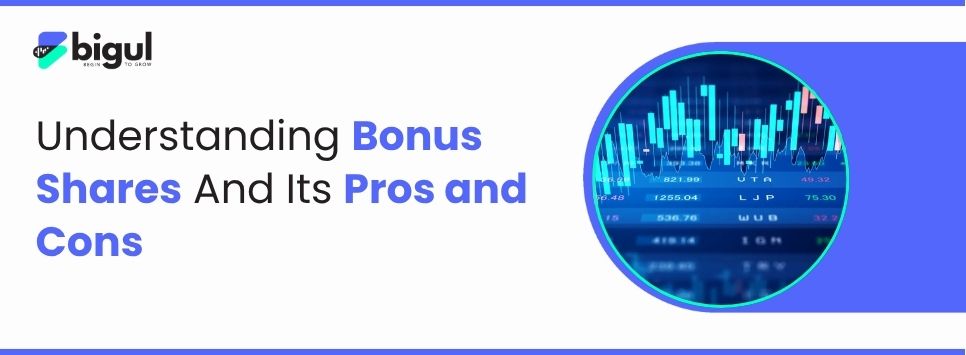Picture this: You check your investment portfolio one morning and discover extra shares in your favourite company magically sitting there, like an unexpected gift. No money left your account; it just... happened. That’s the magic of Bonus shares – a powerful, yet often misunderstood, tool companies use to reward their loyal shareholders.
But what exactly are they, and are they truly as beneficial as they seem? Let’s dive deep into the world of bonus shares, exploring their types, their pros and cons, who qualifies, and why companies choose this path over cold, hard cash Dividends.
So, What Exactly Are Bonus Shares?
Think of Bonus shares as a company saying "thank you" to its owners – the shareholders – by giving them more ownership slices of the pie, absolutely free. Instead of paying out profits as cash Dividends, the company takes a chunk of its accumulated reserves (think retained earnings or share premium) and converts it into brand-new shares. These new shares are then distributed proportionally to existing shareholders based on how many they already own.
For instance, a 1:1 bonus issue means for every single share you hold, you get one additional share free. Your holding doubles! But here's the catch: the share price automatically adjusts downward proportionally. So, if you held 100 shares worth Rs100 each (total value Rs10,000), after a 1:1 bonus, you’d own 200 shares, but each would be priced around Rs50 (keeping your total value at Rs10,000). It’s like slicing your existing pizza into more, smaller slices – the overall pizza size (company value) stays the same, but you have more slices (shares).
Companies favour Bonus shares because they reward Investors without draining precious cash reserves, which can be vital for funding growth or weathering tough times.
The Mechanics: How Do You Actually Get These Bonus Shares? Timing is Everything!
The process hinges on a few critical dates, and one stands out as absolutely crucial: the Ex date. This is the D-day for eligibility. To qualify for Bonus shares, you absolutely must be a registered shareholder before the Ex date. Buying the shares on the Ex date or later means you miss out – the free shares go to the previous owner. Think of the ex-date as the gate closing; you need to be inside before it shuts. Shortly after the Ex date, the company sets a "record date."
On this day, they take a snapshot of all eligible shareholders based on who owned the shares before the Ex date. Within a couple of weeks following the record date, those shiny new Bonus shares get credited directly into the demat accounts of eligible Investors. While the share price drops on the ex-date to reflect the increased number of shares, your overall portfolio value for that stock remains stable initially.
The market then takes over, determining if the price climbs back up based on the company's fundamentals and investor sentiment. Let’s understand the types of shares.
Not All Free Shares Are Created Equal: Understanding the Types
While the concept of free shares sounds simple, there are nuances in how they are structured. Primarily, we talk about two types, though one is far more common today:
1: Fully Paid Bonus Shares (The Standard "Paid Bonus"): This is what Investors encounter almost exclusively in modern markets. These Bonus shares are funded entirely from the company’s reserves (like retained earnings or the share premium account). The key here is that shareholders receive them completely free and clear, with zero further payment required. They are fully paid-up from the moment they are issued, granting the shareholder immediate and complete ownership rights, including voting rights and entitlement to future Dividends. When people talk about a paid bonus, this is almost always what they mean. It’s the straightforward, hassle-free type of bonus issue.
2: Partially Paid Shares (The Largely Historical Relic): This type is much rarer today, often phased out due to complexity. Partially paid bonus shares were also issued free initially, but with a crucial difference: the shareholder was obligated to pay additional instalments in the future to make them fully paid-up. These were typically funded from profits rather than reserves.
Imagine receiving a "voucher" for a share, but you still need to pay the remaining balance later to own it outright. While theoretically offering a way for companies to raise incremental capital later, the administrative burden and complexity for Investors made partially paid shares unpopular. Modern regulations and market practices heavily favour the simplicity of fully paid or paid bonus shares. You’re highly unlikely to encounter partially paid issues as a current investor.
Why Companies Love Issuing Bonus Shares: The Strategic Pros
For the company’s management, distributing Bonus shares isn't just generosity; it's a calculated strategic move with several compelling advantages:
-
Rewarding Loyalty Without Cash Drain: It’s a fantastic way to acknowledge and reward existing shareholders without dipping into the company's cash coffers.
-
Enhancing Perceived Affordability and Liquidity: Post-bonus, the share price is lower. While the company's total market value remains the same, a lower nominal share price often makes the stock appear more affordable and accessible to small retail Investors. This can significantly boost trading liquidity as more buyers enter the market.
-
Signalling Confidence and Strength: A company only issues Bonus shares with healthy accumulated reserves and strong profitability. Announcing a bonus issue sends a powerful positive signal to the market about the company's financial health and its management's confidence in future prospects.
-
Potential Psychological Boost: The psychological satisfaction of seeing your share of stocks doubling or rising sharply may make shareholders hold the stock for the long term.
The Flip Side: Potential Cons and Things to Watch Out For
While Bonus shares offer benefits, they aren't without potential downsides for both the company and the Investors:
-
Earnings Per Share (EPS) Dilution: This is a key financial consideration. Issuing more shares spreads the company’s total earnings over a larger number of shares. Even if profits remain stable, this results in a lower Earnings Per Share (EPS) figure. A declining EPS can sometimes worry Investors focused solely on this metric, potentially dampening the stock's performance in the short term, regardless of the long-term benefits of the bonus itself.
-
Reduced Flexibility with Reserves: The reserves used to issue Bonus shares are essentially locked in as permanent capital. This means those funds are no longer available for potential future cash Dividends, major acquisitions, or other strategic opportunities that might require significant cash outlays. The company trades flexibility for a stronger equity base.
-
No Immediate Cash Benefit for Shareholders: Unlike cash Dividends, which put money directly into Investors' pockets, Bonus shares don't provide immediate spending power. Your wealth is still tied up in the stock. For Investors reliant on income from their investments, this can be a drawback compared to receiving Dividends.
-
Potential for Dividend Per Share Reduction: Following a bonus issue, the total pool of profits available for Dividends is now spread across a larger number of shares. While the company might maintain or even increase the total dividend payout, the dividend per share (DPS) will likely decrease unless profits grow significantly. An Investor holding 100 shares, getting Rs 10 per share as a dividend, receives Rs 1000 total. After a 1:1 bonus, they hold 200 shares. If the company keeps the total dividend payout the same, the DPS might drop to Rs5, still giving the Investor Rs1000 total. But if they were expecting the per-share dividend to stay at Rs 10, they might be disappointed.
-
Market Perception Risk: If the market interprets the bonus issue as a sign that the company has no better use for its reserves (like profitable investment opportunities), the stock price might not recover as expected after the Ex date adjustment, or could even decline further.
Who Gets the Golden Ticket? Understanding Eligibility
The rules for qualifying for Bonus shares are refreshingly straightforward, but absolutely hinge on timing:
-
The Golden Rule: Own Before the Ex Date: This cannot be stressed enough. The single most critical factor is that your name must be on the company's register of shareholders before the Ex date. If you buy the shares on the ex-date itself or later, you are not entitled to the bonus shares for that purchase. The seller, who owned them before the Ex date, will receive them. You must complete your purchase (settled T+1 or T+2 days, depending on the market) well before the Ex date to ensure ownership is recorded.
-
Demat Account Holders: For the vast majority of investors today who hold shares electronically in a demat account, the process is seamless. If you own the shares before the Ex date, the bonus shares will automatically appear in your demat account after the record date, typically within 15 days. No action is usually required on your part.
Conclusion:
Bonus shares constitute an interesting area between company policy and reward to shareholders. They enable corporations to manifest their financial capability, compensate shareholders who are loyal, boost liquidity, and save cash, at the same time forwarding constructive messages to the market. For Investors, they offer the undeniable appeal of increasing their stake in a company they believe in, at zero additional cost, with potential long-term benefits from compounding growth and future Dividends on a larger holding.
Ultimately, a bonus issue is a positive signal, but it shouldn't be the sole reason to invest. Always evaluate the company's underlying fundamentals – its profitability, growth prospects, debt levels, and management quality. A bonus from a fundamentally strong company can be a fantastic long-term wealth builder. A bonus from a struggling company is just more shares in a struggling company.








.jpg)
.jpg)
